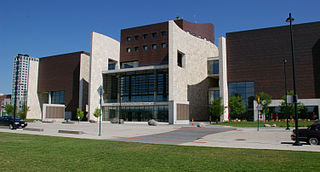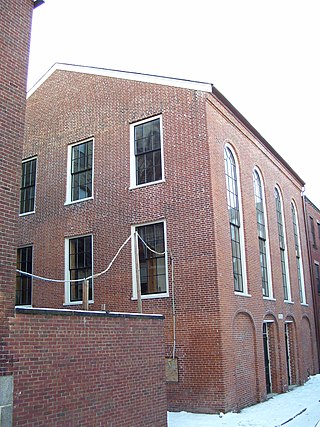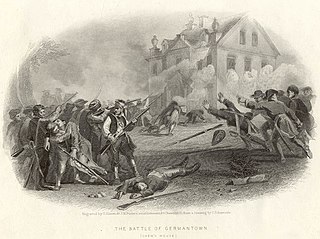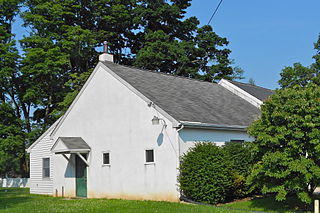
Germantown is an area in Upper Northwest, Philadelphia, United States. Founded by Palatine, Quaker, and Mennonite families in 1683 as an independent borough, it was absorbed into Philadelphia in 1854. The area, which is about six miles northwest from the city center, now consists of two neighborhoods: 'Germantown' and 'East Germantown'.

The National Underground Railroad Freedom Center is a museum in downtown Cincinnati, Ohio, based on the history of the Underground Railroad. Opened in 2004, the Center also pays tribute to all efforts to "abolish human enslavement and secure freedom for all people."

Thomas Garrett was an American abolitionist and leader in the Underground Railroad movement before the American Civil War. He helped more than 2,500 African Americans escape slavery.

The Boston African American National Historic Site, in the heart of Boston, Massachusetts's Beacon Hill neighborhood, interprets 15 pre-Civil War structures relating to the history of Boston's 19th-century African-American community, connected by the Black Heritage Trail. These include the 1806 African Meeting House, the oldest standing black church in the United States.

The Colonial Germantown Historic District is a designated National Historic Landmark District in the Germantown and Mount Airy neighborhoods of Philadelphia, Pennsylvania along both sides of Germantown Avenue. This road followed a Native American path from the Delaware River just north of Old City Philadelphia, through Germantown, about 6 miles northwest of Center City Philadelphia, and on to Pottstown. Settlement in the Germantown area began, at the invitation of William Penn, in 1683 by Nederlanders and Germans under the leadership of Francis Daniel Pastorius fleeing religious persecution.

Milton House is a historic building located at 18 South Janesville Street in Milton, Wisconsin. It was a stop on the Underground Railroad, a network of people and places that facilitated the movements of escaped slaves. The building has been asserted to be the first grout building built in the United States; although that claim is dubious, the house's grout construction apparently was influential. The AIA Journal called it the "Oldest standing concrete structure of any consequence." It is also known for its hexagonal shape.

The F. Julius LeMoyne House is a historic house museum at 49 East Maiden Street in Washington, Pennsylvania. Built in 1812, it was the home of Dr. Francis Julius LeMoyne (1798–1897), an antislavery activist who used it as a stop on the Underground Railroad. LeMoyne also assisted in the education of freed slaves after the American Civil War, founding the historically black LeMoyne–Owen College in Memphis, Tennessee. His house, now operated as a museum by the local historical society, was designated a National Historic Landmark in 1997. It is designated as a historic public landmark by the Washington County History & Landmarks Foundation.

Historic RittenhouseTown, sometimes referred to as Rittenhouse Historic District, encompasses the remains of an early industrial community which was the site of the first paper mill in British North America. The mill was built in 1690 by William Rittenhouse and his son Nicholas on the north bank of Paper Mill Run near Philadelphia, Pennsylvania. The district, off Lincoln Drive near Wissahickon Avenue in Fairmount Park, includes six of up to forty-five original buildings. RittenhouseTown was listed on the National Register of Historic Places and was designated a National Historic Landmark District on April 27, 1992.

Rokeby Museum is a historic farm property and museum at 4334 United States Route 7 in Ferrisburgh, Vermont. The 90-acre (36 ha) property includes a 1780s farmstead, and eight agricultural outbuildings with permanent exhibits. Hiking trails cover more than 50 acres (20 ha) of the grounds. Rokeby is open from mid-May to mid-October each year. The property was designated a National Historic Landmark in 1997 for its association with Rowland T. Robinson, a Quaker and ardent abolitionist who openly sheltered escaped slaves at Rokeby as part of the Underground Railroad. Robinson's extensive correspondence is an essential archive giving insight into the practices of abolitionists and the operations of the railroad.

The Nathan and Mary (Polly) Johnson properties are a National Historic Landmark at 17–19 and 21 Seventh Street in New Bedford, Massachusetts. Originally the building consisted of two structures, one dating to the 1820s and an 1857 house joined with the older one shortly after construction. They have since been restored and now house the New Bedford Historical Society. The two properties are significant for their association with leading members of the abolitionist movement in Massachusetts, and as the only surviving residence in New Bedford of Frederick Douglass. Nathan and Polly Johnson were free African-Americans who are known to have sheltered escaped slaves using the Underground Railroad from 1822 on. Both were also successful in local business; Nathan as a caterer and Polly as a confectioner.

The John P. Parker House is a historic house museum at 300 North Front Street in Ripley, Ohio. It was home to former slave and inventor John P. Parker (1827–1900) from 1853 to his death in 1900. Parker was an abolitionist and a well-documented conductor on the Underground Railroad, helping hundreds of escaped slaves. The house was listed on the National Register of Historic Places in 1980, and it was further designated a National Historic Landmark in 1997. It is now owned and managed by a local nonprofit organization as a museum about Parker's life and the abolitionist movement.

Ercildoun, population about 100, is an unincorporated community in East Fallowfield Township, Chester County, Pennsylvania, United States. The hamlet was founded by Quakers and was an early center of the abolitionist movement. In 1985 the entire hamlet, including 31 properties, was listed as a historic district on the National Register of Historic Places. Of these properties two were vacant land, 14 were significant buildings, ten were contributing buildings, and five buildings, built in the 1950s, were non-contributing. The Lukens Pierce House, an octagon house listed separately on the U.S. National Register of Historic Places, is located about half a mile northwest of the hamlet. Ercildoun is one of about ten hamlets in the township, which has no cities or towns, but has 31 sites listed on the National Register. It is one of the larger hamlets, located near the center of the township, and historically among the best known. The city of Coatesville is about 3 miles north.

Bethel AME Church, now known as the Central Pennsylvania African American Museum, is a historic African Methodist Episcopal church at 119 North 10th Street in Reading, Berks County, Pennsylvania. It was originally built in 1837, and is a 2½-storey brick and stucco building with a gable roof. It was rebuilt about 1867–1869, and remodeled in 1889. It features a three-storey brick tower with a pyramidal roof topped by a finial. The church is known to have housed fugitive slaves and the congregation was active in the Underground Railroad. The church is now home to a museum dedicated to the history of African Americans in Central Pennsylvania.

The Ebenezer Maxwell House, operated today as the Ebenezer Maxwell Mansion, is an historic house located in the West Germantown neighborhood of Philadelphia, Pennsylvania.

The Marais des Cygnes Massacre Site, also known as Marais des Cygnes Massacre Memorial Park, is a state historic site near Trading Post, Kansas that commemorates the 1858 massacre of the same name. On May 19, 1858, during a period of political instability and sporadic violence known as Bleeding Kansas, a group of pro-slavery border ruffians captured 11 abolitionist free-staters. The prisoners were forced to a nearby ravine, where 10 of them were shot, resulting in five fatalities. The abolitionist John Brown later built a fort near the site. The first commemoration at the site was two stone markers erected by men of the 3rd Iowa Cavalry Regiment in 1864, although these monuments had been destroyed by souvenir hunters by 1895. In 1941, the land where the massacre occurred, as well as an 1870s-era house constructed by a friend of Brown, were transferred to the state of Kansas. The site was listed on the National Register of Historic Places in 1971 and designated a National Historic Landmark in 1974. The Kansas Historical Society administers the site, which is interpreted by signage and a hand-cranked audio recording.

The Hovenden House, Barn and Abolition Hall is a group of historic buildings which are located in Plymouth Meeting, Whitemarsh Township, Montgomery County, Pennsylvania. In the decades prior to the American Civil War, this property served as an important station on the Underground Railroad. Abolition Hall was built to be a meeting place for abolitionists, and later was the studio of artist Thomas Hovenden.

Thomas Rutter was an American ironmaster and abolitionist who constructed the first blast furnace and the first iron forge in the Province of Pennsylvania. Now known as Pine Forge Mansion and Industrial Site, the location of Rutter's mansion and iron plantation was listed on the National Register of Historic Places in 2004. The site has been the campus of Pine Forge Academy since 1945.




















